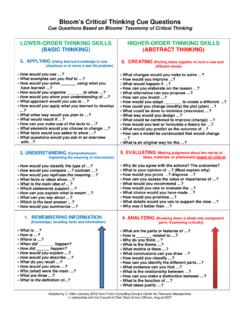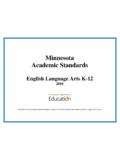Transcription of Standards for Language Arts College Success
1 English Language ArtsCollege Board Standards for College Success 2006 The College Board. All rights reserved. College Board, Advanced Placement Program, AP, SAT, and the acorn logo are registered trademarks of the College Board. connect to College Success and SAT Readiness Program are trademarks owned by the College Board. PSAT/NMSQT is a registered trademark of the College Board and National Merit Scholarship Corporation. All other products and services may be trademarks of their respective owners. Visit the College Board on the Web: Outline ..iiiIntroduction to College Board Standards for College Success ..viIntroduction to English Language arts ..xiReading Standards ..1 Writing Standards ..37 Introduction to Communication ..127 Speaking Standards ..131 Listening Standards .
2 153 Media Literacy Standards ..171 Glossary ..189 References ..197 Table of Contents 2006 The College BoardFollowing is an outline of the Standards and objectives that make up the English Language arts College Board Standards for College Success . Standards Outline iiiStandards Outline 2006 The College BoardReading StandardsSTANDARD 1 Comprehension of Words, Sentences, and Components of Student comprehends the meaning of words and Student comprehends elements of literary Student comprehends organizational patterns, textual features, graphical representations, and ideas in informational and literary 2 Using Prior Knowledge, Context, and Understanding of Language to Comprehend and Elaborate the Meaning of Student uses prior knowledge to comprehend and elaborate the meaning of Student uses context to comprehend and elaborate the meaning of Student uses knowledge of the evolution, diversity, and effects of Language to comprehend and elaborate the meaning of 3 Author s Purpose, Audience.
3 And Student rhetorically analyzes author s purpose, intended audience, and Student interprets, analyzes, and critiques author s use of literary and rhetorical devices, Language , and 4 Using Strategies to Comprehend Student uses strategies to prepare to Student uses strategies to interpret the meaning of words, sentences, and ideas in Student uses strategies to go beyond the Student uses strategies to organize, restructure, and synthesize text Student monitors comprehension and reading strategies throughout the reading StandardsSTANDARD 1 Rhetorical Analysis and Student analyzes components of purpose, goals, audience, and 2 Generating Student takes inventory of what he or she knows and needs to Student generates, selects, connects, and organizes information and Student generates text to develop points within the preliminary organizational Student makes stylistic choices with Language to achieve intended 4 Evaluating and Revising Student evaluates drafted text for development, organization, and Student evaluates drafted text to determine the effectiveness of stylistic 5 Editing to Present Technically Sound Student edits for conventions of standard written English and Student employs proofreading strategies and consults resources to correct errors in spelling, capitalization.
4 And Student edits for accuracy of citation and proper use of publishing Student prepares text for College Board Standards for College Success 2006 The College BoardSpeaking StandardsSTANDARD 1 Understanding the Communication Student understands the transactional nature of the communication 2 Speaking in Interpersonal Student communicates in one-to-one Student plans for and participates in group 3 Preparing and Delivering Student analyzes purpose, audience, and context when planning a presentation or Student gathers and organizes content to achieve purposes for a presentation or Student rehearses and Student presents, monitors audience engagement, and adapts StandardsSTANDARD 1 Understanding the Communication Student understands the transactional nature of the communication 2 Managing Barriers to Student manages barriers to 3 Listening for Diverse Student listens to Student listens to Student listens Literacy StandardsSTANDARD 1 Understanding the Nature of Media Student understands the nature of media 2 Understanding, Interpreting, Analyzing, and Evaluating Media Student understands, interprets, analyzes, and evaluates media 3 Composing and Producing Media Student analyzes purpose, audience, and media channel when planning for a media communication.
5 Student develops and produces an informational or creative media Student evaluates and revises a media Outline v 2006 The College BoardThe College Board has developed Standards for English Language arts to help states, school districts, and schools provide all students with the rigorous education that will prepare them for Success in College , opportunity in the workplace, and effective participation in civic life. The College Board s commitment to this project is founded on the belief that all students can meet high expectations for academic performance when they are taught to high Standards by qualified teachers. College Board programs and services have supported the transition from high school to College for more than 100 years. Advanced Placement Program (AP ) courses enable students to transition into College -level study when they are ready, even while still in high school.
6 The SAT Reasoning Test , the SAT Subject Tests , and the PSAT/NMSQT all measure content knowledge and critical thinking and reasoning skills that are foundations for Success in College . The College Board Standards for College Success makes explicit these College readiness skills so that states, school districts, and schools can better align their educational programs to clear definitions of College readiness. Preparing students for College before they graduate from high school is critical to students completing a College degree. Most College students who take remedial courses fail to earn a bachelor s degree (Adelman, 2004). To reduce the need for remediation in College , K 12 educational systems need clear and specific definitions of the knowledge and skills that students should develop by the time they graduate in order to be prepared for College Success .
7 By aligning curriculum, instruction, assessment, and professional development to clear definitions of College readiness, schools can help reduce the need for remediation in College and close achievement gaps among student groups, ultimately increasing the likelihood that students will complete a College degree. The design of the College Board Standards for College Success reflects the specific purposes of this framework to vertically align curriculum, instruction, assessment, and professional development across six levels beginning in middle school leading to AP and College readiness. The College Board Standards for College Success is, therefore, more specific than most Standards documents because it is intended to provide sufficient guidance for curriculum supervisors and teachers to design instruction and assessments in middle school and high school that lead toward AP and College readiness.
8 The College Board uses these frameworks to align its own curriculum and assessment programs, including SpringBoard , to College readiness. States and districts interested in integrating SpringBoard and AP into a program of College readiness preparation can use the College Board Standards for College Success as a guiding of the English Language arts College Board Standards for College SuccessThe College Board initiated the effort to develop Standards for English Language arts in 2003. To guide the process, the College Board convened the English Language arts Standards Advisory Committee, comprising middle school and high school teachers, College faculty, subject matter experts, assessment specialists, teacher education faculty, and curriculum experts with experience developing content Standards for states and national professional organizations (see committee roster).
9 The committee first defined the academic demands students will face in an AP or first-year College course in English Language arts . This involved reviewing the assessment frameworks for relevant AP exams, SAT, PSAT/NMSQT, Introduction to College Board Standards for College Successvi College Board Standards for College Success 2006 The College BoardCollege-Level Examination Program (CLEP ) exams, and selected university placement programs. The committee also reviewed the results of several surveys and course content analyses conducted by the College Board to provide empirical validation of the emerging definitions of College readiness. In English Language arts , a nationally representative sample of 1,044 English and humanities College faculty and 1,307 high school English teachers responded to a College Board survey designed to determine the reading and writing skills faculty and teachers feel are critical to Success in first-year College courses (Milewski, Glazer, Johnsen, & Kubota, 2005).
10 Further empirical data were developed through a three-year national study sponsored by the Association of American Universities (AAU) and conducted by the Center for Educational Policy Research (CEPR) at the University of Oregon. This study surveyed more than 400 College faculty and administrators at nine AAU universities throughout the nation to define the knowledge and skills necessary for successful performance in entry-level College courses. Definitions of College readiness gathered through these surveys, course analyses, and case studies represent the most rigorously researched, empirically validated definitions of College readiness available. Having established clear and specific definitions of the knowledge and skills that students need to succeed in College , the committee articulated a developmental progression of student learning objectives across six levels that would lead all students to being prepared for AP or College -level work.




